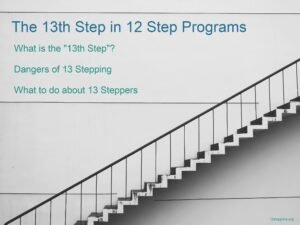
Home » 12 Step Programs
12 Step Programs
What are 12 step programs? 12-step programs are a method used for treatmentA blanket term for concentrated efforts to help addicts transition to a healthier life. These can include any of the following (in isolation or combination): therapy, counseling, medication, harm reduction, or moderation. More for & recoveryThe process by which addicts attempt to break the hold a certain substance or behavior has on their lives. This can refer to participation in a wide variety of methods. What they all have in common, is a sense that life is improving and the addict is regaining control. More from addiction. They engage the spiritual and psychological roots of addiction. At the onset, 12 step programs were focused squarely on alcoholics via Alcoholics AnonymousThe original 12-step fellowship, formed in 1935, to help alcoholics, regain control over their lives. It remains the largest 12-step organization and has contributed to the sobriety of millions worldwide. Read more about Alcoholics Anonymous More. AA was formed in Akron, Ohio, in 1935. As a result of its success and popularity, several related groups were created over the decades to help a variety of addictions; from drugs to sexual or behavioral compulsions to overeating.
Today we consider alcoholism and other forms of addiction to be a disease. However, until 1935 (and well beyond), it was commonly believed that addiction was a choice and, therefore, a glaring moral failure.
The twelve stepsThe term “12 steps” refers to the core principles of the approach to addiction exemplified by Alcoholics Anonymous and other similar groups. The 12 steps are a set of guidelines designed to help individuals overcome addiction and rebuild their lives. They were created by the founders of Alcoholics A… More are designed to aid anyone with an addiction and a genuine desire to recover.
Lists of 12 Step Programs
Find information on 12 step programs for:
12 Step Program Principles
Although every group has its spin on the fundamental doctrine and steps involved, they all ascribe to the same core principles. One of the most important principles is the belief in the sustaining aid of a Higher Power. Though fundamentally spiritual, all 12-step programs avoid veering into religious territory. The original 12-steps mention God by name. However, the higher power12-step programs greatly stress surrender to and daily communication with a Higher Power. Having trust in something greater than yourself is considered essential for returning sanity in the unmanageable life of an addict. This can be a traditional deity, a spiritual entity or a social one such as th… More in question can be God in the traditional religious sense. However, it can also be an abstract power or a human institution such as the 12-step group. What matters is not the identity of the power but rather the acknowledgment that our recovery depends on something greater and more profound than the inner psychology of the individual.
Whether it functions as the Higher Power in question or not, the group is a central component of all 12-step programs. Groups meet regularly and have ascribed rules that protect the anonymityAlcoholics Anonymous and all the 12 step groups modeled after it, protect the anonymity of its members. Members are forbidden from disclosing the identity of other addicts to outside sources or identifying themselves with the group on any form of public media. The idea behind this is to focus on the… More of members and encourage sharing12-step meetings are structured so that member sharing takes up most of the allotted time. It is the bread and butter of the fellowship between members. When sharing, addicts are encouraged to stay on topic and avoid interrupting by engaging in crosstalk. More and support without harmful judgment.
12 Step Program Sponsorship
Another element designed to give emotional and spiritual support to recovering addicts is the institution of sponsorship. A sponsor is a fellow recovering addict, ideally with more significant experience and insight into the process of rehabilitation. The 12th step speaks of a mission “to carry this message to alcoholics.” As such, sponsorship and serviceAA and other 12-step fellowships do not normally have employees. Instead, members volunteer and take roles necessary for the operation of the different groups and the larger infrastructure of the fellowship. Common roles of service include secretary, treasurer, and chairing meetings. More to the group are not only the right thing to do, they also contribute to the recovery of the sponsorAn individual in a 12-step program requires a sponsor to help them work the steps and hold them accountable for their recovery. The sponsor should be readily available when help is needed. A member with a sponsor is considered to be the sponsee. More.
The twelve steps at the center of the programThis refers to any official course of treatment for addiction. This could be anything from in-patient facilities, to 12-step programs to harm-reduction programs. More involve finding a spiritual center and building character. The philosophy behind this is that an individual must commit a fearless moral inventory into their lives and habits before overcoming addiction. By looking honestly at both the behavior that accompanies addiction and its causes, addicts can begin the long but fulfilling rebuilding process.
The goal of a 12-step programA 12 step program includes 12 steps of recovery to help those struggling with substance addictions or behavioral addictions. The 12 steps are also used in programs dedicated to helping loved ones of addicts. 12 step programs include 12 step meetings where members go to share their experience strengt… More is not limited to treating addiction. After all, the destructive behavior that accompanies addiction is a symptom rather than the cause of pain. Therefore, AA literature insists that following this approach closely “as a way of life can expel the obsession to drink and enable the sufferer to become happily and usefully whole.”
As a tried and tested road to recovery, it is worth considering for anyone suffering from debilitating habits.
Do 12 Step Programs Work and Why?
For many years there was an air of mystery around 12-step programs. Some people felt like it was the answer to all of their addiction problems. Meanwhile, others accused groups like AA of being cults.
One of the reasons for the mysterious aura surrounding these programs is the anonymity surrounding them. It has made it difficult to make an objective assessment of their effectiveness.
The Evidence
In recent years some reliable studies on the effectiveness of AA and other 12-step programs have been released and we can gauge their effectiveness fairly well. As it turns out, they work quite well!
An academic study conducted in 2003 found that individuals who regularly attended meetings in the first 3 years of their recovery, improved the odds of maintaining abstinenceThe act of not partaking in the substance or activity to which a member is addicted. The length of sobriety of addicts is determined following the period of abstinence. More from alcoholAn organic compound used in many products, most notably intoxicating drinks. Alcohol addiction is known as alcoholism. The first 12-step program was devised to deal with that malady. More by 35%. In a longer-term study conducted 3 years later, psychologists found that amongst recovering addicts who regularly attended meetings 67% were abstinent at the end of the allotted period, while only 34% of the control group managed to remain dry.
AA also fares well in comparison to cognitive addiction therapy. Another study found that between 22% and 37% of heavily engaged AA participants remain dry in the long-term. Meanwhile, those participating in cognitive therapy enjoyed long-term sobrietyIn 12-step programs, an individual is sober when they are no longer partaking in the behavior or substance to which they are addicted and living a better life following the program. Both are necessary to achieve sobriety. More 15% to 25% of the time.
If so, 12- step programs are no magic bullet for addiction. Many people are not helped by them. But if AA is any indication, it fares better than most other forms of addiction therapy. For that reason, most rehabilitation facilities incorporate some element of 12-step therapy in their programs.
The evidence would appear to suggest that 12-step programs work. The question remains, why?
Belief in a Higher Power
Most people believe in God or a spiritual system of one kind or another. Many others believe in astrology, angels, nature, or something else greater than themselves. It is part of human nature. Our tendency to look for meaning and significance helps us overcome hard times.
12-step programs channel this human need to help addicts recover. They encourage addicts to surrender control over their lives to a Higher Power and believe that it has a plan for them. Addicts come to understand that they have lost control over the lives and addiction has rendered them unable to make good decisions.
Belief in a Higher Power also focuses addicts on something other than their own narrow and selfish needs. A self-centered focus on fulfilling narrow needs is often at the heart of addiction. Also, the damage done to others comes out of a self-absorbed focus on the narrow needs of the addictAn individual with an unhealthy dependence on a substance or behavior. An individual remains an addict even years into recovery and must therefore remain active in recovery. Read more about drug & alcohol addiction & withdrawal at Withdrawal Info. More. A focus on a Higher Power can help refocus this energy on to others to the benefit of recovery and the wider community.
The 12-steps focus on accepting the plan of a Higher Power for the life of the addict, substituting their flawed plan and judgment for a greater will and purpose. Countless success stories have shown that this can inspire people to remain sober and begin a new life that is focused on helping others. The meaningful content of a life blessed by the presence of a Higher Power helps fill up the emotional hole that was once filled by addiction.
The Group
Loneliness and isolation play a large role in self-destructive behavior. It often leads to pain at the core of the addiction. Then addiction increases isolation by driving the important people in one’s life away.
Addicts feel crushed by the weight of their loneliness and the fear that they will never belong again. This is where the group and the fellowshipThis refers to the members of AA and the bonds of support between them. It is this fellowship that allows addicts to share their stories and accept each other in a world that is not always understanding. More at its core come into play. The group makes it much harder to feel alone in one’s addiction. The meetings and shares are a reminder that the pain is shared by others and some people understand.
The more veteran members of the group lead by example and show those suffering that there is hope. This in itself is invaluable and serves as an antidote to the desperation which feeds the addiction.
What can a newcomerAn individual attending a 12-step meeting for the first time. In most cases, they meet with a veteran member first. More expect when going to their first 12 step meeting? In the first meeting, the newcomer is presented with the phone numbers of other members. Members are also encouraged to find a sponsor. This means that whenever an addict feels isolated or in danger of relapseRelapse in the context of 12-step programs refers to the act of reverting to harmful behaviors associated with addiction after a period of recovery. This return to substance use or compulsive behavior disrupts the recovery process and often leads to a resurgence of destructive patterns that the indi… More, they can reach out to a variety of understanding people. Very often after meetings or on weekends, members of the group engage in social activities together.
In conjunction with the role of a Higher Power, the group reduces isolation and desperation. People are happier when they are accepted as part of society.
Service
The final step in the program is to spread the message to suffering addicts. Indeed, once those engaged in the program are stable they are encouraged to serve as sponsors to others with less experience in the program. Members also perform service to the group by running meetings, purchasing literature and chips, making coffee, and answering phones at the head office.
Once they have completed the steps, members report that they are far more giving to their community and families. They feel like contributing members of the wider society around them.
In conclusion, 12-step programs work by removing the sense of isolation and desperation at the core of addiction. Filling the hole that once drove addiction is a belief in a path determined by a Higher Power, the support of the group, service, and the renewed role of family and community in the lives of those who once suffered.
History of the 12 Steps
If you or a loved one has been around addiction, you might have heard the phrase, “Have you worked the steps?” Even if you can’t understand why or have tried everything to stop before, there is a 12 Step program for you. It’s simple, but not easy.
Any addiction can leave a person’s life unmanageable, financially bankrupt, and in detoxAn important step in recovery from harmful substances. This is the process of allowing the body to recover from the damage done through overconsumption. When dependence is very heavy, detox should be done under medical professional oversight. More or rehabRehabilitation from addiction to a substance or harmful behavior. The term is often used to refer to in-patient facilities. Rehab usually consists of an intensive course of behavior modification which may include therapy, medication, and oversight. More. It doesn’t matter what the addiction is, whether it be alcohol, drugs, sex, smoking, food, sugar, gambling, or internet gaming, working a 12-step program promises a solution to your problem.
The history of the 12 Steps began over 80 years ago, when a New York business man and an Ohio doctor began a fellowship with the goal of helping fellow alcoholics regain and retain their sobriety. Over time, the group drafted a list of guiding principles intended to aid the recovery process on every level – physical, mental, emotional, and especially, spiritual. Thus, Alcoholics Anonymous (AA) was born along with the 12 Steps.
Originally, the 12 Steps were created from the personal experiences of recovery from alcoholism. Although AA was intended specifically for those individuals whose lives were being made unmanageable by alcohol, the philosophies of those original guiding principles – now called the 12 Steps – can be applied to every person suffering from any addiction. Over the years, the 12 Steps have been adapted by other 12-step and addiction recovery groups, such as Gamblers Anonymous and Narcotics AnonymousNA is the second-largest 12-step program. Formed in 1953, it is designed to help those who wish to recover from drug addiction. More, to those struggling with other forms of addiction. Additionally, many groups have changed the spiritual overtones of the original 12 Steps to reflect more agnostic philosophies.
There are no other requirements to joining a 12 Step group other than having a desire to stop using the addictive substance (alcohol for AA). Those attending a 12 Step group make a commitment to join either voluntarily, as a continuation of therapy or by court mandated rehab.
12 Step Program FAQs
There are many 12 step programs for various issues but as a beginner, we know that there are a lot of questions surrounding what a 12 step program is, whether or not they are religious organizations how to find a meeting and more. We’ve put together of the most common 12 step -related questions below.
What are the 12 steps?
The 12 steps vary from program to program. While Alcoholics Anonymous was the creator of the first set of 12 steps, each program has found a way to implement a specific addiction into its steps. The wording may be a bit different from program to program, but the basis of each membership is to admit powerlessness over your addiction and accept that a higher power can help guide you to recovery.
Is being religious a requirement for 12-step programs?
There are no religious requirements for any 12-step programs. Although a higher power is mentioned in the 12 steps, members are not required to believe in God or have any religious preferences at all. The step regarding a higher power was put in place to help members find a power greater than themselves in their own, individualistic way.
How often should you attend 12-step meetings?
Every memberAn individual who attends 12-step program meetings and has the desire to overcome addiction. More can choose to attend meetings as often or as little as they’d like. It’s important to find meeting times that are nearby so that attendance is never an issue. For many new members, attending more meetings can be helpful in getting through the difficult times of recovery. Once members have found what meetings they like and what times are convenient for them, they can set a routine to regularly make it to their “home” meetings.
How effective are 12-step programs?
While 12-step programs never guarantee recovery for anyone, studies have shown that they are effective in treating addictive and compulsive behaviorsThese are behaviors in engaging in due to a strong urge to do so. Compulsion may be difficult to control but is mostly manageable. If compulsion turns into addiction, the problem becomes more severe. More. Alcoholics Anonymous and Narcotics Anonymous have both conducted surveys that can display recovery rates, as well as many other 12-step programs. These programs work for individuals who choose to work their way through the program. Many 12-step programs have been around for decades simply because they provide members with success at recovering from their addiction and living healthy and successful lives.
What are the 12 steps in Alcoholics Anonymous?
Because Alcoholics Anonymous was the first 12-step program ever developed, many of these programs follow the same basic principles and steps that were created in Alcoholics Anonymous. The 12 steps in Alcoholics Anonymous are as follows:
1. We admitted we were powerless over alcohol – that our lives had become unmanageable.
2. Came to believe that a Power greater than ourselves could restore us to sanity.
3. Made a decision to turn our will and our lives over to the care of God as we understood him.
4. Made a searching and fearless moral inventoryStep 4 recommends the addict conduct “a searching and fearless moral inventory.” This involves coming to terms with the flaws which preceded addiction and those that came as a result of it. More of ourselves.
5. Admitting to God, to ourselves and to another human being the exact nature of our wrongs.
6. Were entirely ready to have God remove all these defects of character.
7. Humbly asked Him to remove our shortcomings.
8. Made a list of all persons we had harmed and became willing to make amends to them all.
9. Made direct amends to such people wherever possible, except when to do so would injure them or others.
10. Continued to take personal inventory and when we were wrong, promptly admitted it.
11. Sought through prayer and meditation to improve our conscious contactBuilding a relationship with a Higher Power is a crucial element in recovery. This involves conscious contact with a Higher Power through prayer and meditation regularly. More with God as we understood Him, praying only for knowledge of His will for us and the power to carry that out.
12. Having had a spiritual awakening as the result of these steps, we tried to carry this message to alcoholics and to practice these principles in all our affairs.
How do you find a 12-step meeting or program?
Regardless of what program is needed to help an addict in recovery, a search on Google can help individuals narrow down what program they are searching for and where they can find one in their area. Every 12-step program’s website should be able to guide newcomers and current members to find a meeting local to them so that they can begin their journey to recovery.
How many 12 step programs are there?
There are a total of 34 official 12-step programs including programs for substance abuseThe use of a drug in a quantity that is harmful to the user mentally or physically. Death and serious harm are usually caused by regular abuse rather than the casual use of drugs. More, food addiction, behavioral addictions12-step programs were originally designed to aid with substance abuse. However, many also find it useful to deal with behavior disorders. This can apply to any behavior which is destructive to the individual engaging in it, but which they are unable to control. More and lifestyle compulsions. In each category, there are programs specific to one area so, within the substance abuse category, there are specific programs for alcohol, pills, methamphetamineA central nervous system stimulant used as a recreational drug. Commonly known as meth, it is one of the most popular and destructive drugs in the United States. Its consumption and production involve major health and societal risks. More, nicotineA stimulant naturally produced and present in tobacco. It is highly addictive and therefore one of the most problematic elements associated with smoking. It can be used in gum and patches to aid addicts in withdrawal from smoking. Read more about the 12 step program for nicotine addiction called Nic… More, marijuanaThis psychoactive drug from the Cannabis plant is perhaps the most common recreational drug in the world. It has strong medicinal benefits but can also cause physical harm and psychological dependence. Marijuana has a much lower social stigma than in the past and is now legal in many countries and U… More and cocaineA strong stimulant developed initially for medical purposes, but now used primarily as a recreational drug. It is an addictive drug; however, it induces mental rather than physical withdrawal symptoms. More. Within the food addiction category of programs there are programs that focus solely on eating too much, general food addiction issues and issues related to disorders like anorexia, binging, purging and bulimia.
What is a 12-step program?
Many 12-step programs were developed based on the basic principles of the first 12-step program, Alcoholics Anonymous. They are in place to help address the issues of individuals seeking recovery from their addiction regardless of what it may be. These programs implement twelve steps to help members recover and address all the effects of addiction including the physical, mental and emotional aspects.
What can you expect from a 12-step meeting?
While every 12-step program is different, they all have the same intentions of meeting a generalized goal – to help individuals abstain from using whatever they are addicted to, whether it be alcohol, drugs, gambling, etc. Every group meeting allows members to acknowledge their addiction, discuss their experiences with another and build a support system within the fellowship of each individual organization.
How much does a 12-step program cost?
One of the benefits of joining a 12-step program is that there is no cost or fees. While these programs are not forms of medical treatment, they are available to anyone and everyone who is willing to participate and abstain from whatever it is they are struggling with. There are no dues or fees for members of 12-step programs; these programs are usually self-supporting and are generally run by volunteers of each membership.
How do you know which program is right for you?
Because joining a 12-step program will cost you nothing, it’s okay for some trial and error. Finding the right group that addresses your addiction is going to be extremely beneficial for recovery, so it’s important to try a few meetings and see which ones best fit your needs. Every program is different and every group has members that will share their stories for you to decide if the program is the right fit. Finding similarities in stories that other members share may help in picking a program to help recover from your addiction.
How will a 12-step program help?
When Alcoholics Anonymous was started, the founders of the organization knew that the only way they could stay clean and sober was to not only abstain from drinking alcohol, but to attend meetings to discuss their struggles, experiences, strengths and hope with other people like them. Each 12-step program is a little different in its own way, but all focus on the same goal as Alcoholics Anonymous. Every program was developed with the intention to ensure its members that they are never alone and that there are people struggling with addictions just like them.
The Importance of the 12 Steps in Recovery
For decades, health care professionals have argued both for and against the integration of 12-step work into addiction treatment. As with any therapeutic approach, the importance of these 12 Steps in recovery/sobriety is broken down into PROS and CONS.
CONS: Healthcare professionals have criticized these programs for several reasons:
- Lack of Proof
- Spirituality
- Lack of Cooperation with Healthcare Providers
PROS: Millions of people endorse these 12 Steps for these important reasons:
- Proven Effectiveness
- Knowledgeable Peer Role Modeling and Feedback
- Availability of Meetings between Treatment Sessions
- Healthy and Support Social Environment
- Lifetime Aftercare
- Availability of Books, Workshops, Podcasts
- Holistic and Inclusive Approach
- No Cost or Time Limitations
The Significance of the 12 Steps in Recovery
At their core, the 12 Steps of any anonymous program (Alcoholics Anonymous, Narcotics Anonymous, Gamblers Anonymous, Overeaters Anonymous, Sexaholics Anonymous, etc.) are a step-by-step outline of the journey that leads from the suffering of active addiction to the serenityOne of the goals of recovery in 12-steps and many other formats is the attainment of serenity. It is dissatisfaction and disquiet which often drives addictive and destructive behavior and attaining a level of serenity nips cravings in the bud. In 12-step fellowships, this is often cultivated through… More of sober living. This path is open to anyone who finds themselves living an unmanageable life because they are powerless over their addiction.
The 12 Steps are meant to provide a clear, workable, and realistic guideline for changing patterns of behavior and helping to alter the fundamental modes of thinking that have fueled an addict’s “substance” abuse for so long. For example, in AA people say that beneath a person’s “drinking problem” lies a deeper “thinking problem” that needs to be overhauled.
Each of the 12 Steps help addicts of every kind move closer towards fully realizing the extent of their addiction while attempting to fix the harm that their substance abuse has caused themselves and others. These 12 step meetings help to keep recovering addicts from returning to destructive behaviors and create a new purposeful sober life.
These 12 Steps are also meant to connect individuals going through similar hardships so that the support and guidance of a like-minded community can help reinforce long-term sobriety and provide the motivation that’s essential for permanent recovery.
In theory, taking the actions for each Step as outlined in Alcoholics Anonymous (AA) allows two things to occur, simultaneously:
1. The first thing is that the ego is deflated and the personality is changed; the inner addict is suppressed by taking actions that level one’s pride, confess their shortcomings, and require self-searching.
2. The second thing is that the inner good of a person is nourished, the spirit – the healthy part always connected to a Higher Power – by ensuring that one makes an honest, authentic connection with themselves, others and/or a Higher Power in each Step.
Once one has worked the 12 Steps, they have new skills to cope with life when things get hard, skills they now have to practice daily to live happily in recovery. Living in the solution of these steps, one can no longer point fingers or blame others for their emotional outbursts or impulsive decisions. When one is disturbed, they must search within themselves for the cause. Whatever happens in life, this “design for living” allows any addict to have peace of mind by working these spiritual principles.
According to a person in recovery who has worked the 12 Steps, “I am responsible for my own happiness. So today when I’m off-center, I have a set of tools to inventory what’s going on in me, identify what I need to do to come back into balance, and, if I find myself not using the tool, I can call on others who understand these principles and pray to a higher power to help me use them promptly and properly.”
About the 12 Steps and 12 Traditions
In a 12-Step program, a person strives for an ever deeper understanding of these Steps, and seek the wisdom to apply them to their lives. Working these steps can be vital to progress in the 12-Step program. The principles they embody are universal, applicable to everyone, and absolutely inclusive.
The 12 Steps of Alcoholics Anonymous are:
- We admitted we were powerless over alcohol — that our lives had become unmanageable.
- Came to believe that a power greater than ourselves could restore us to sanity.
- Made a decision to turn our will and our lives over to the care of God as we understood Him.
- Made a searching and fearless moral inventory of ourselves.
- Admitted to God, to ourselves, and to another human being the exact nature of our wrongs.
- Were entirely ready to have God remove all these defects of character.
- Humbly asked him to remove our shortcomings.
- Made a list of all persons we had harmed, and became willing to make amends to them all.
- Made direct amends to such people wherever possible, except when to do so would injure them or others.
- Continued to take personal inventory and when we were wrong promptly admitted it.
- Sought through prayer and meditation to improve our conscious contact with God as we understood Him, praying only for knowledge of His will for us and the power to carry that out.
- Having had a spiritual awakening as the result of these Steps, we tried to carry this message to others, and to practice these principles in all our affairs.
The 12-step programs of recovery are based on the 12 Steps and 12 TraditionsThe term “12 traditions” refers to a set of principles that guide the functioning and decision-making of 12-step recovery organizations such as Alcoholics Anonymous (AA). The traditions were first published in 1946 and are intended to allow the organizations to run smoothly while protecting the anon… More of Alcoholics Anonymous. The Steps are the foundation for personal recovery and the Traditions help groups sustain their unity and fellowship. Essentially, the 12 Traditions are guidelines to promote harmony and growth in 12-Step groups and amongst the worldwide fellowship.
The following are the 12 Traditions of Alcoholics Anonymous that serve as a guideline to define the inner workings of the 12-step programs:
- Our common welfare should come first; personal recovery depends upon A.A. unity.
- For our group purpose, there is but one ultimate authority—a loving God as He may express Himself in our group conscience. Our leaders are but trusted servants; they do not govern.
- The only requirement for A.A. membership is a desire to stop drinking.
- Each group should be autonomous except in matters affecting other groups or A.A. as a whole.
- Each group has but one primary purpose: to carry its message to the alcoholicAn individual with an unhealthy dependence on alcohol. From the perspective of AA, it is an individual who has lost control over their life due to an inability to stop drinking. More who still suffers.
- An A.A. group ought never endorse, finance, or lend the A.A. name to any related facility or outside enterprise, lest problems of money, property, and prestige divert us from our primary purpose.
- Every A.A. group ought to be fully self-supporting, declining outside contributions.
- Alcoholics Anonymous should remain forever non-professional, but our service centers may employ special workers.
- A.A., as such, ought never to be organized; but we may create service boards or committees directly responsible to those they serve.
- Alcoholics Anonymous has no opinion on outside issues; hence the A.A. name ought never to be drawn into public controversy.
- Our public relations policy is based on attraction rather than promotion; we need always maintain personal anonymity at the level of press, radio, and films.
- Anonymity is the spiritual foundation of all our traditions, ever reminding us to place principles above personalities.
Staying Safe in 12-Step Programs
Staying safe in 12-step programs is crucial, especially for newcomers sharing personal details with strangers. Concerns about trust violations and predatory behaviors, like the ‘Thirteenth Stepping’ phenomenon, are real. These issues not only pose a risk to individuals but also to the group’s primary goal of aiding recovery.
Participants are advised to take immediate action if they feel threatened, such as seeking support from other group members or involving law enforcement in severe cases.
Despite the autonomous nature of 12 step groups, maintaining a safe environment is essential. Adhering to the Twelve Traditions, groups should address disruptive behaviors promptly to ensure both individual and group welfare in the recovery journey. Find out more.






Step 12 – What it is and what it means to carry the message and practice the principles

Step 11 – Through Prayer and Meditation, We Seek to Improve our Conscious Contact with God



Step 7 – Humbly Asking our Higher Power to Remove Our Shortcomings



Step 4 – Why it’s Important and What a ‘Searching and Fearless Moral Inventory’ Means


References
The 12 Steps Of AA | Alcoholics Anonymous Program. Alcohol.org. https://www.alcohol.org/alcoholics-anonymous/. Published 2020. Accessed October 6, 2020.
Northpoint Staff. The Science behind the 12 Steps of Narcotics Anonymous. Northpoint Recovery’s Blog. https://www.northpointrecovery.com/blog/science-behind-12-steps-narcotics-anonymous/. Published November 15, 2016. Accessed October 5, 2020.
Kaskutas LA. U.S. National Library of Medicine. Alcoholics Anonymous Effectiveness: Faith Meets Science. Journal of addictive diseases, 2009:28(2), 145–157.
Europe PMC. Europe PMC. Europepmc.org. https://europepmc.org/article/med/8464933. Published 2019. Accessed October 4, 2020.
Alcoholics Anonymous World Services, Inc. Alcoholics Anonymous: The Story of How Many Thousands of Men and Women Have Recovered From Alcoholism. Published 2001.
APA PsycNet. Apa.org. https://psycnet.apa.org/doiLanding?doi=10.1037%2Fa0029268. Published 2020. Accessed October 4, 2020.
Steps, Traditions and Concepts | Alaska Al-AnonA group designed for friends and family of alcoholics. Using the 12-step program as adapted to this purpose, it helps affected individuals deal with the consequences of addiction while supporting the addict in their lives. More Family Groups. Al-anon-ak.org. https://al-anon-ak.org/steps-traditions-and-concepts-page/. Published 2019. Accessed October 5, 2020.
Wilson, B. Alcoholics Anonymous : Read the Big BookThe basic text of AA was the first to methodically introduce the 12-steps. It is still the main source for meetings and is quoted in just about all AA and other 12-step literature. the Library of Congress named it one of the 88 “Books that shaped America.” Read more about the Big Book of AA. More and 12 Steps and 12 Traditions. Aa.org. https://www.aa.org/sites/default/files/literature/p-91_An_Introduction_To_Our_Twelve_Traditions.pdf. Published 2020. Accessed October 5, 2020.
Finley, JR. Integrating the 12 Steps into Addiction Therapy. Google Books. https://books.google.com/books?hl=en&lr=&id=by9aH1yarQC&oi=fnd&pg=PR7&dq=12+steps+12+traditions+recovery&ots=9o7NFSquAI&sig=T0OvZ5kUo0XCpfg84F0OaSXqkis#v=onepage&q=12%20steps%2012%20traditions%20recovery&f=true. Published 2010. Accessed October 4, 2020.
Living the 12 Steps. Hazeldenbettyford.org. https://www.hazeldenbettyford.org/articles/campbell-rice/living-the-twelve-steps. Published 2016. Accessed October 5, 2020.
Wendy Kissin, Caroline McLeod, James McKay,
The longitudinal relationship between self-help group attendance and course of recovery,
Evaluation and Program Planning, Volume 26, Issue 3, 2003, Pages 311-323, ISSN 0149-7189 https://www.sciencedirect.com/science/article/pii/S0149718903000351. Published 2003. Accessed September, 2021.
